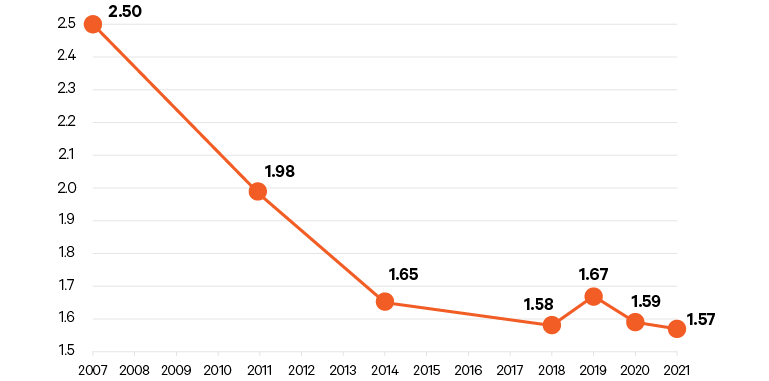
The importance of finding more sustainable ways to live our lives has become abundantly clear over recent years. Businesses have faced increased pressure to adhere to these new sustainability practices and find ways to pass on these practices to their customers where possible.
Vertiv has taken its role in reducing environmental impact seriously, taking every step it can to reduce its environmental impact as well as helping its customers improve their sustainability too.
There are many small steps you can take to reduce your environmental impact, including setting goals, evaluating, and prioritising any steps possible toward sustainability.
Let’s see all the ways Vertiv can help you in your sustainability journey!
Establishing Goals
Before you begin looking into any new equipment or methods to implement, it’s important to create a plan around specific goals you may have. These goals may include decreasing the carbon footprint of your data center, reducing power consumption or water use, or optimizing supply chain operations.
A popular goal for data centers is based on the vision of ‘net zero’ data centers which encompasses:
- Zero losses: Eliminating inefficiencies and maximizing utilization.
- Zero carbon: Eliminating carbon emissions from the power consumed.
- Zero water: Eliminating the dependence on water for operations.
- Zero waste: Eliminating the e-waste created by operations.
Defining Frameworks and Metrics
When choosing the goals you want to achieve, it is important to make sure they are measurable and achievable. Using frameworks and metrics to help define your goals can help you ensure success and help build out a plan for this.
For many, emissions will be your primary target to reduce your environmental impact. The Greenhouse Gas (GHG) Protocol provides comprehensive, global frameworks to help organizations to understand and reduce their emissions. According to the GHG Protocol, these emissions include:
Scope One: Emissions from owned and operated assets.
These emissions would include that data center facilities, IT, and other equipment owned by the company (including vehicles). Construction methods and material choices will also be included here.
Scope Two: Missions from the generation of purchased energy.
Utilities are still limited in their ability to be able to meet the power demands of data centers on carbon-free energy alone. This results in power purchase agreements being made by data center operators to offset the carbon emissions from the purchased energy.
Scope Three: Emissions from everything else.
This can include suppliers, distributors, product use, and more. These emissions are much harder to measure as they include the actions and assets of a third-party.
You can use the Calculation tools provided by the GHG Protocol to help you to quantify the emissions created by your organisation.
Prioritizing Opportunities
Many data centers that have already begun to make changes have used a multi-tiered and phased approach to this new challenge. This can start with something as simple as an evaluation of your existing data center systems and prioritizing the opportunities to make changes based on the technologies that are currently available.
A way many have started is by introducing virtual servers, hot-aisle or cold-aisle containment or free cooling technology to reduce the inefficiencies in their operations. There are many other opportunities that can be considered to help you reach your goals too, including:
Increasing Asset Utilization.
Infrequently experiencing peak demands and redundancy needed in critical systems often leads to assets becoming underutilized. By introducing cloud-based services to your data center you will be able to turn off little-used servers to boost utilization rates in IT systems. By using power equipment that can operate at rated capacity, leveraging the UPS system’s overload capacity at demand peaks, and using high-utilization N+ 1 power system architecture, you can drive higher utilization of critical power equipment.
Optimizing infrastructure efficiency.
Power Usage Effectiveness, or PUE, is the most common metric that is used to assess the efficiency of data centers. It is calculated by dividing the amount of power entering the data center by the amount used to support the IT load, with the goal being to get the result as close to a 1:1 ratio as possible. Worldwide, the average for a data center is 1.57, but more efficient data centers have maintained levels of 1.2. This shows that there is a significant opportunity for improvements here to match those more efficient data centers.

Transitioning to renewable energy.
Sadly, renewable energy isn’t predictable enough at the moment to directly power always-on data centers. With the criticality of the equipment staying on, any fluctuations or dropouts, no matter how brief, can lead to outages and causes harm to the IT equipment. However, by pairing renewable energy sources with systems cable of producing hydrogen from renewable sources, the hydrogen can then power the data center when the renewable energy is not delivering the required power. Whilst this is not an ideal solution right now, these technologies are constantly advancing and are worth keeping an eye on for the future.
Decreasing water usage.
Whilst water-intensive cooling technologies have traditionally been used by organizations to reduce their PUE, new options are now emerging that can help you to reduce, or even eliminate, your water consumption. Water Usage Effectiveness (WUE) is calculated by dividing the amount of water a site uses by its total IT equipment energy usage and can be used to measure your water efficiency. Finding more water-conserving options may be particularly important for businesses that operate in areas where the water available is more scarce or for those who have listed water consumption as one of their main environmental issue goals.
Reducing e-waste.
Partnering with electronic recycling companies can help data centers to recycle more of the materials in their electronic components and to ensure the responsible disposal of all e-waste produced. Online guides can also provide helpful information on ways to reduce, recycle and dispose of electronic equipment. Some companies you find may even reuse, repurpose, or resell your used device to prolong the lifecycle of your discarded products.
Optimizing the supply chain.
Just as Vertiv is trying to help its customers to make positive changes, data center owners and operators are often in similar positions to help drive change with the companies they work with. Incentives to meet certain targets, or working together to adopt circular economy processes can be beneficial for all parties.
As you can see, there is no single solution to reducing your environmental impact, but there are many steps that can be taken to help.
To see some of Vertiv’s solutions to help you build a more sustainable setup, check out our Sustainability Spotlight blog and our Innovations For Reduced Environmental Impact.
More Vertiv Products Available from Comms Express:
Vertiv Data Centre UPS | Vertiv Rack Cooling | Vertiv KVM & Console Drawer Solutions | Vertiv Server Cabinets | Vertiv PDUs | Vertiv UPS
If you require any further information on these or any other products that we stock here at Comms Express, please do not hesitate to contact our team who will be only too happy to help.
Until next time…
